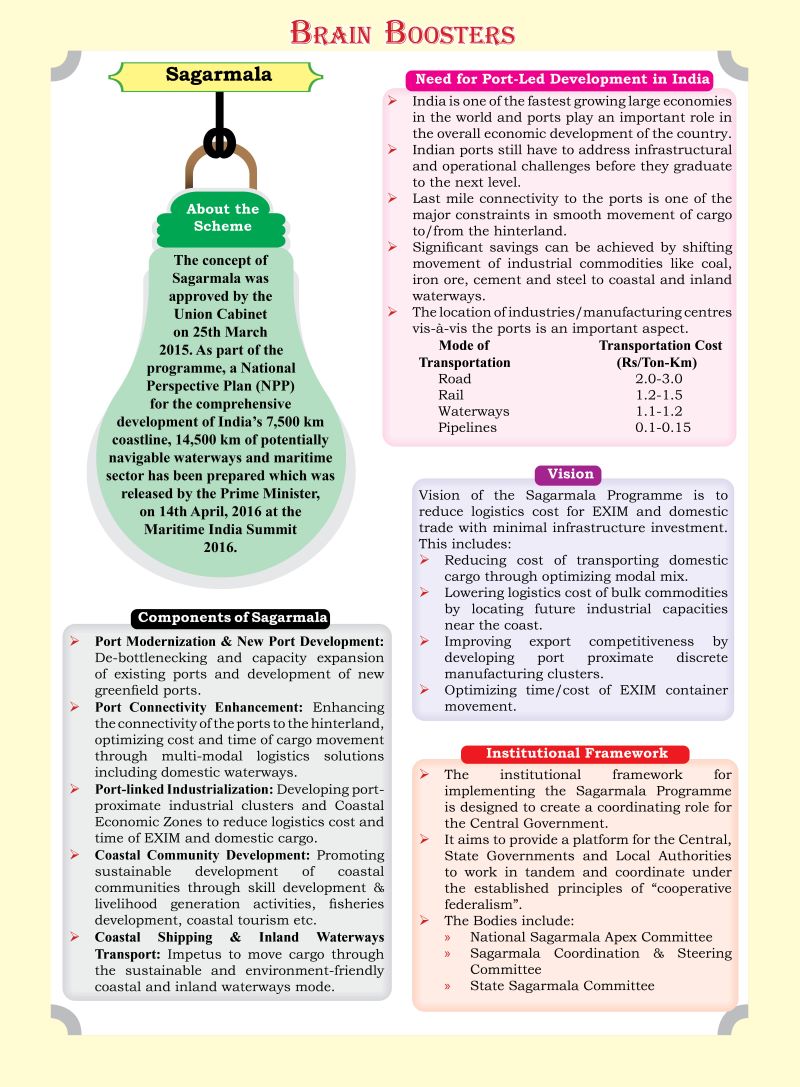1. About the Scheme
The concept of Sagarmala was approved by the Union Cabinet on 25th March 2015. As part of the programme, a National Perspective Plan (NPP) for the comprehensive development of India’s 7,500 km coastline, 14,500 km of potentially navigable waterways and maritime sector has been prepared which was released by the Prime Minister, on 14th April, 2016 at the Maritime India Summit 2016.
2. Components of Sagarmala
- Port Modernization & New Port Development: De-bottlenecking and capacity expansion of existing ports and development of new greenfield ports.
- Port Connectivity Enhancement: Enhancing the connectivity of the ports to the hinterland, optimizing cost and time of cargo movement through multi-modal logistics solutions including domestic waterways.
- Port-linked Industrialization: Developing port- proximate industrial clusters and Coastal Economic Zones to reduce logistics cost and time of EXIM and domestic cargo.
- Coastal Community Development: Promoting sustainable development of coastal communities through skill development & livelihood generation activities, fisheries development, coastal tourism etc.
- Coastal Shipping & Inland Waterways Transport: Impetus to move cargo through the sustainable and environment-friendly coastal and inland waterways mode.
3. Need for Port-Led Development in India
- India is one of the fastest growing large economies in the world and ports play an important role in the overall economic development of the country.
- Indian ports still have to address infrastructural and operational challenges before they graduate to the next level.
- Last mile connectivity to the ports is one of the major constraints in smooth movement of cargo to/from the hinterland.
- Significant savings can be achieved by shifting movement of industrial commodities like coal, iron ore, cement and steel to coastal and inland waterways.
- The location of industries/manufacturing centres vis-à-vis the ports is an important aspect.
Mode of Transportation Cost Transportation (Rs/Ton-Km) Road 2.0-3.0 Rail 1.2-1.5 Waterways 1.1-1.2 Pipelines 0.1-0.15
4. Vision
Vision of the Sagarmala Programme is to reduce logistics cost for EXIM and domestic trade with minimal infrastructure investment. This includes:
- Reducing cost of transporting domestic cargo through optimizing modal mix.
- Lowering logistics cost of bulk commodities by locating future industrial capacities near the coast.
- Improving export competitiveness by developing port proximate discrete manufacturing clusters.
- Optimizing time/cost of EXIM container movement.
5. Institutional Framework
- The institutional framework for implementing the Sagarmala Programme is designed to create a coordinating role for the Central Government.
- It aims to provide a platform for the Central, State Governments and Local Authorities to work in tandem and coordinate under the established principles of “cooperative federalism”.
- The Bodies include:
- National Sagarmala Apex Committee
- Sagarmala Coordination & Steering Committee
- State Sagarmala Committee







